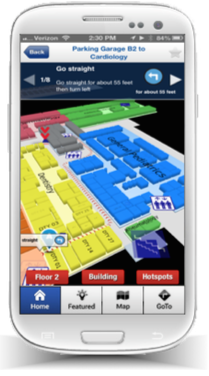- April 22, 2015
- Joe
- knowledge
- No Comments
 Some time ago we talked about the challenges for indoor location services. At that time Qualcomm proposal seemed interesting. Time has passed and now this offer is a little more mature and -at least- available as a finished product.
Some time ago we talked about the challenges for indoor location services. At that time Qualcomm proposal seemed interesting. Time has passed and now this offer is a little more mature and -at least- available as a finished product.
Still, there’s no standard way to provide indoor location, as it is the case with GPS. Whatever indoor location method is adapted, is proprietary and -thus- attached to its respective manufacturer.
There are several existing mobile indoor location solutions. The most prominent is from an Austrian company called indoo.rs. It’s a pretty neat solution as it uses whatever devices installed on premises (WiFi access points, bluetooth beacons and cell tower signal) to map and triangulate indoor user position. This means little or no investment in hardware on premises, in order to achieve indoor positioning for mobile devices. This is an important advantage to adopt this platform, as it might be costly to equip a mall with beacon, regardless of how cheaper they’re. For deployment, is just necessary to embed the indoor.rs SDK within a mobile and indoor location is possible. Of course, is not that simple, but that’s the basic idea on how it works.
Enter, CISCO Hyperlocation
CISCO adopted Qualcomm proposal, and it sells it as Hyperlocation. Of course, CISCO is mainly a network gear vendor, as such, Hyperlocation release in hardware & software with this capabilities. The way it works is by installing an extra module on current CISCO’s WiFi access points. Once these modules are installed, they can provide indoor location to mobile devices, with a precision of 1 meter. That’s the basics on how it works.
Details
Of course, the devil is in the details. It is evident that for such a solution to work, a CISCO WiFI network must be installed. Which may or not be a good thing. If it is installed AND the access points model are compatible with the Hyperlocation solution, then it is a no brainer. Also, if the situation is calling for an upgrade, considering Hyperlocation is also a good option. After that, then is the software to manage all this. But of course, we’re talking here of an investment of several thousand of dollars.
For a mobile app to support this, the Cisco Mobile Concierge SDK must be used. Hyper location solution can pinpoint the location of the mobile device, by way of getting this data through the API available from hyper location services.
The important thing is, given the physical impossibility of GPS signals to work under a roof (indoors), these are one of the few options that enable the magic of indoor location to happen. Enjoy! 🙂
